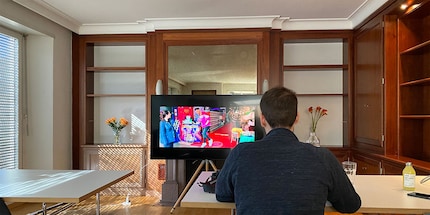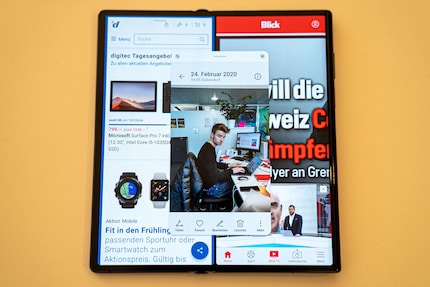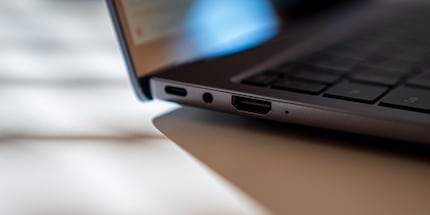
Background information
Huawei without Google Services: A look at the Mate 30 and the future of Android
by Dominik Bärlocher

Huawei surprises. In addition to the expected Mate Xs and the new laptops, the company is also showing a new Android tablet.
MWC 2020 will not take place. Huawei has therefore invited people to Zurich, where a small local event will be held.

The product launch, which will be broadcast live on tape - i.e. recorded live at an earlier point in time - will be held under the motto "Together 2020". Speaker Andrew Garrihy, Huawei's Global Chief Brand Officer, is not referring to some vague feeling in the Marketing Community, but to closing the gaps in users' personal ecosystems. The boundary between PC, smartphone, smart screen and all other devices should become blurred or even disappear completely.
Richard Yu, CEO Huawei Consumer Business Group, takes the stage. The man talks charmingly and cheekily. He's clearly missing the audience, I realise after a few words - because Richard likes to celebrate himself and his products at events like this. Not today, because the coronavirus is stealing the show. He's in Barcelona, he says. It doesn't matter. Live streams are coming from everywhere.
Yu talks about Huawei's business figures. They are in the top 2 global brands in terms of smartphones and business is not getting worse despite the economic war. On the contrary: growth is continuing.
Despite this, Huawei still sees itself in the unfavourable role of being a pawn in the economic war between the USA and China. US companies have been banned from doing business with Huawei since May 2019. Among them: Google. This makes employees working with Android impossible for Huawei, a company that likes to be at the forefront. The integration of Google mobile services is not possible, even if Huawei can still work with Android itself. A free version of Android is available for everyone to download and modify.
Richard Yu does not really address this situation, but elegantly disguises the fact that current Huawei phones no longer come with Google Mobile Services. However, these can be retrofitted at your own risk. Only at the end of the keynote is there something that is built up narratively as a side blow. But this then fizzles out into "HMS Core is a new product as an alternative to Google". No political statement, no specific direction, but plenty of subtext.
Richard Yu goes from CEO to nerd as soon as he talks about smartphones. He pulls out the new Huawei Mate Xs 5G. It has a screen diagonal of 8 inches. The phone folds outwards with the screen, which exposes the display to all kinds of environmental factors. This is why the Mate Xs is double-foiled.
The phone cannot open accidentally. This is because the hinge is locked with a latch to prevent it from slipping when it is folded. It then measures just over 6" diagonally. At the edge, however, there is a quad camera setup, including a time-of-flight camera, which sets the focus faster and more reliably.
Richard is obviously proud of the Kirin 990 5G. It is 14 per cent smaller than the Snapdragon 865 and performs much better in the areas of AI and 5G. The Kirin 990 responds to more 5G frequency bands, which should make reception better.

With the Mate Xs, Huawei is under pressure to optimise its software so that more complex processes and multitasking are possible. The fact that two apps can be arranged next to each other is nothing new. But a third app can be superimposed in a window. If you drag an image into a Messenger window, the image is automatically sent to the contact.
Cost point international: 2499 euros. Ouch.
Tablets, especially those based on Android, have a hard time. Cynics and critics decry Android tablets as useless, poorly maintained and often simply existing so that something can compete with the top dog, the iPad. Or should. Or simply so that some shareholder is satisfied and can say "Yes, yes, the tablet - that's important to us" before forgetting that there is anything other than the iPad.
Huawei dares to take the tablet step. With four speakers, a dual camera setup and a screen diagonal of 10.8 inches, the MatePad Pro is quite nice to look at. Unlike other Android manufacturers such as Samsung, Huawei doesn't skimp. A Kirin 990 5G is installed and can be charged with 40 watts of supercharging, 27 watts wirelessly.
The gap is also closed here. Similar to how you can see on your iPad when someone calls you on your iPhone, you can connect your MatePad and your Huawei smartphone. The rest of the features, the keyboard, the pen, the customisable screen angle... we know that from the iPad.
Except that in addition to black and white, the MatePad also comes in orange and blue vegan leather. Yes, dear vegans, you can grumble that leather is not vegan by default. I know that, you know that, Richard Yu knows that, but "polymer with a natural feel" doesn't roll off the tongue quite as well. So I apologise for that.
The Matepad costs from 549 euros upwards to around 700 euros.
The Matebook X Pro, Huawei's new flagship laptop, is ultra-slim and has a webcam next to the F5 button that can be retracted into the casing. The resolution of the Matebook X Pro is 3000×2000 pixels on a touchscreen. Underneath, an Intel Core i7 10th Gen slumbers in a metal unibody. It comes in grey, green and silver.
The Huawei Share feature is particularly special. It seamlessly sends images from your smartphone to your laptop and allows you to remotely control your smartphone from Windows. Otherwise, Richard Yu spends very little time on the device. He is known for being a smartphone nerd and can talk about it on stage forever. He finds all three new Huawei laptops cool, but can't get as deep into the topic as he can with smartphones. Even the 15.6-inch diagonal Matebook D 15, the larger sibling of the D 14, doesn't really excite him - despite the AMD Ryzen 7 GPU and a completely new ventilation concept.

The Matebook utilises a Shark Fin fan design, which is supposed to increase airflow by a third, making cooling more efficient. Oh, and there's a USB 3.0 port.
If you miss ports on your Macbook for a reason I can't quite understand, then the Matebook D is for you. Because the Matebook is aimed at these people: Apple fans or those who like the feel of the Macbook, but also Windows. Ports are at least there if you want a USB 3.0 port and an HDMI port. The Macbook only has USB-C ports and a headphone jack.
All laptops support the new WiFi standard WiFi 6+. WiFi 6 was once called WiFi 802.11 ax, but has now been renamed WiFi 6 for ease of use. It's faster, more dynamic and basically what you want in a laptop.
Richard Yu can't avoid the economic war after all. He promotes the Huawei App Gallery, which is still quite China-heavy. But he talks about it being a serious competitor to Google's Play Store and Apple's App Store. This is at least theoretically possible, but still some way off.
The localisation of apps is progressing, but key apps are still missing.
Then there are the Quick Apps, Huawei's version of apps that don't need to be installed. Essentially, if I've understood correctly, these are progressive web apps that simply land on your home screen via a shortcut.
Luckily! At last! Huawei has entered into a partnership with Cewe. Now you can create your photo books, which according to editor Simon Balissat look like they were designed by a woman in her mid-40s in the midst of divorce and self-discovery, directly on your phone.
Huawei is also investing one billion US dollars in app development. And then money has gone into developing a commercial for the App Gallery. Nice.
In the wider context of the world of electronics, Huawei is still probably the most exciting company currently in existence. This is because political tensions could bring Huawei to its knees. But the company is big enough to survive the whole thing. And it has sufficient resources to develop alternatives that will immediately find the distribution they need to stay. Anything is possible, from bankruptcy to serious competition.
So it remains exciting.
Journalist. Author. Hacker. A storyteller searching for boundaries, secrets and taboos – putting the world to paper. Not because I can but because I can’t not.
From the latest iPhone to the return of 80s fashion. The editorial team will help you make sense of it all.
Show all